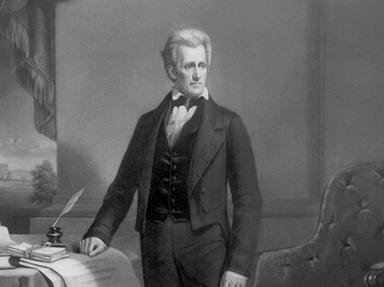Quiz Answer Key and Fun Facts
1. Which incident left two physical scars that President Andrew Jackson carried on his left hand and face for most of his life?
2. President Andrew Jackson is considered the founder (if not, the co-founder) of which modern political party in the United States?
3. As of 2008, the parents of President Andrew Jackson were the only parents of a president who were which of these?
4. In striking contrast to the tragedies inflicted on Native Americans through the policies of President Andrew Jackson, in 1813 he adopted and raised a Creek Indian boy as his son. Which is the name of his adopted Native American son?
5. As of 2008, President Andrew Jackson received on March 27 1834 what no other US President has acquired before or since. Which item was given to him?
6. Which modern convenience did President Andrew Jackson install at the White House?
7. Keeping intact the provisions of the Missouri Compromise of 1820, one "slave" and one "free" state were added to the Union during the Presidency of Andrew Jackson. Which two states were added?
8. Only 17 Presidents of the United States have appointed Chief Justices to the United States Supreme Court. Who did President Andrew Jackson appoint as Chief Justice on March 28 1836?
9. The 1998 design of the US $20 dollar bill altered the portrait of President Andrew Jackson as an anti-counterfeiting measure. Which other Jacksonian hallmark was entirely removed from the other side of the bill in 1998?
10. There are three equestrian statues of President Andrew Jackson sculpted by Clark Mills. One is in Washington, D.C. and a second in Nashville, Tennessee. Where is the third statue located?
Source: Author
socalmiguel
This quiz was reviewed by FunTrivia editor
Bruyere before going online.
Any errors found in FunTrivia content are routinely corrected through our feedback system.

